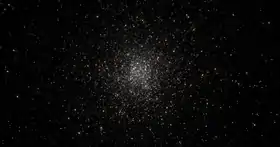| NGC 6139 | |
|---|---|
 NGC 6139, imaged by the Hubble Space Telescope | |
| Observation data (J2000 epoch) | |
| Class | II[1] |
| Constellation | Scorpius |
| Right ascension | 16h 27m 41.6s[2] |
| Declination | –38° 50′ 18″[2] |
| Distance | 10.1 kiloparsecs (30 kilolight-years)[3] |
| Apparent magnitude (V) | +9.68[4] |
| Apparent dimensions (V) | 1.6′ x 1.4′[4] |
| Physical characteristics | |
NGC 6139 is a globular cluster of the Milky Way in the constellation Scorpius. It is located 3.6 kiloparsecs (10 kilolight-years) from the Galactic Center[3] (less than half the distance of the Sun from the Galactic Center).
Visibility
The cluster appears visibly small and requires larger +12" aperture telescopes to view the core. Appearing around 1.5 arcmins having a radius of .75 arcmins, despite its rather bright magnitude.
Visibility
 Globular clusters are denser and more spherical than open star clusters.[5]
Globular clusters are denser and more spherical than open star clusters.[5]
References
- ↑ "Results for NGC 6139". VizieR Catalogue Database. Retrieved 2013-09-06.
- 1 2 "NED Results for NGC 6139". NASA/IPAC Extragalactic Database. Retrieved 2013-09-06.
- 1 2 Harris, William E. (1996). "A Catalog of Parameters for Globular Clusters in the Milky Way (2010 edition)". Astronomical Journal. 112: 1487. doi:10.1086/118116.
- 1 2 "NGC 6139". SIMBAD. Centre de données astronomiques de Strasbourg. Retrieved 2013-09-06.
- ↑ "An aging beauty". www.spacetelescope.org. Retrieved 25 June 2018.
External links
 Media related to NGC 6139 at Wikimedia Commons
Media related to NGC 6139 at Wikimedia Commons
This article is issued from Wikipedia. The text is licensed under Creative Commons - Attribution - Sharealike. Additional terms may apply for the media files.